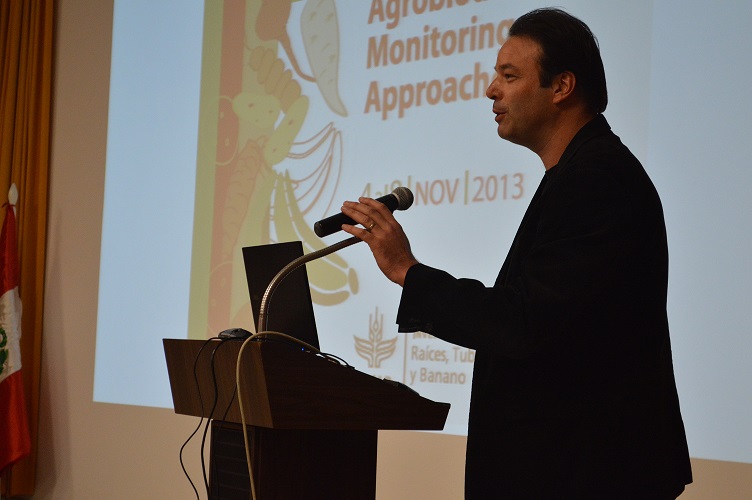Several economic and ecological factors threaten the biological options required to ensure food security, causing a loss of agrobiodiversity, defined as all the diversity existing within and among the species found in the domesticated systems, including wild relatives and species that interact with pollinators, pests, parasites, and other organisms. “The consequences are serious, irreversible, and global,” declared the FAO in 1996 in its State of the World’s Plant Genetic Resources for Food and Agriculture. How can this loss be counteracted? To be able to address it, we need to measure it, say the experts. This was the premise under which the first International Meeting on the Systematic Monitoring of Agrobiodiversity in its centers of origin was held in Huancayo and in Lima, Peru, from November 4 to 8, 2013.
The international event, the first of its kind anywhere in the world, was attended by some 40 experts from 15 countries and 25 institutions, including governmental and non-governmental organizations, and research centers belonging to CGIAR, such as Bioversity International, the International Center for Tropical Agriculture (CIAT), the International Potato Center (CIP), and the International Institute of Tropical Agriculture (IITA). The participants held a workshop in the INIA Santa Ana experimental station in Huancayo, Peru, from November 4 to 7, before presenting the results to decision-makers and potential donors on November 8 in the CIP headquarters in Lima, with a view to putting forward recommendations on how to support the systematic monitoring and its integration into the national strategies.
The objective of the experts gathered in Peru was to share the latest methods and indicators for the systematic monitoring of the diversity of crops and their wild relatives in their centers of origin. Another objective was to define standardized procedures to be shared among organizations and countries, and to prioritize replicable methods that could be applied at the global level and in the long term to produce timelines.

Stef de Haan presenting the conceptual framework
The final outcome of the four days of work was an international conceptual and operative framework for monitoring agrobiodiversity, which was presented on the last day of the event by Stef de Haan, the leader of CIP’s Genetic Resources Program. Four levels of monitoring were identified: genetic diversity, diversity of species and varieties, diversity of agricultural landscapes or agroecosystems, and the collective knowledge associated with agrobiodiversity.
Previously, Adam Drucker, economist of Bioversity International, had pointed out that “the losses, which can be irreversible, are not well identified, and we don’t even have indicators. So it is necessary for monitoring to be done with a standardized system and common observation parameters.”
He added that “domesticated biodiversity is a consequence of the deliberate intervention of the human being” and that the crops in the farmers’ fields are not static: on the contrary, they are constantly being selected by the human hand and by the environment, hence the need to study the evolution in situ.
De Haan told the gathering that the methods, variables, and indicators suggested by the experts would soon be published as procedures. He also reported that among the group of experts specific routes had been identified for implementation at pilot level. Nevertheless, “A strategic support is required to make the implementation materialize at the political and institutional levels, as well as with international cooperation,” he affirmed.

Participants in the Huancayo workshop
The organizing committee for the event was composed of Bioversity International, the International Potato Center (CIP), the National Institute of Agricultural Innovation (INIA), the Peruvian Ministry of the Environment (MINAM), and the Yanapai Group. The event was supported by the CGIAR Research Program on Roots, Tubers and Bananas (RTB).
Some of the participating institutions were: Agropolis Foundation, Bioversity International, CADEP-JMA-Peru, CET-Chiloe, CIAT, CIRAD, Conservation at Native Seeds/SEARCH, CORPOICA-Colombia, EMBRAPA, IITA, INIA-Chile, INIA-Peru, INIAF-Bolivia, INIAP-Ecuador, Ministry of Environment-Peru, PROINPA, Universidad Nacional Agraria La Molina, University of Birmingham/School of Biosciences, UNORCAC, YANAPAI Perú.
